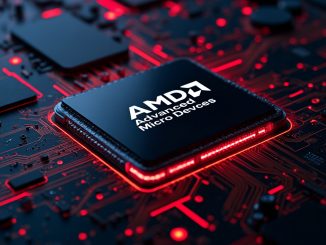
AMD’s stock price lost nearly 16% of its value Thursday after the world’s second-largest maker of PC microprocessor chips reported Q3’18 revenue of $1.65 billion, up 4.4% from $1.58 billion in the year-ago period but below the $1.7 billion that Wall Street was expecting. Non-GAAP EPS came in at $0.13, up from $0.09 in the prior-year period and a penny higher than analyst estimates. Sales in enterprise, embedded and semi-custom unit fell 5% to $715 million. The chipmaker also guided Q4 revenue 8% higher year-over-year (y/y) to $1.45 billion, well below the Street’s $1.59 billion average forecast.
Advanced Micro Devices (NASDAQ:AMD) said revenue from its computing and graphics business segment, which includes processors for PCs-Ryzen, servers, and graphics cards (GPUs), was $938 million, up 12% y/y but down 14% quarter-over-quarter with “negligible” Radeon sales to cryptocurrency miners.
While the company cited elevated gaming GPU channel inventory for the lackluster sales, caused by the decline in blockchain-related demand, it noted that the sales only accounted for a “high single digit percentage” of its revenue.
“Client and server processor sales increased significantly although GPU inventories ended up being larger than expected,” Lisa Su, AMD’s chief executive said during a post-earnings interview on CNBC.
Clearly, AMD’s growth momentum is taking a pause here due to disruptive influences including higher interest rates, tariff concerns which have weighed on the entire sector recently and excess inventory levels. According to Stifel’s Kevin Cassidy however, the inventory can be cleared by Q1’19, leaving room for AMD’s refreshed GPU products. Su seems to be on the same wavelength with that approach as she remains confident about the chipmaker’s product pipelines for both of its CPU and graphics businesses.
We will be “competitive in high-end graphics,” she said. “We’re making high-performing quality products and building a solid long-term foundation.”
In fact, gross margin in the third-quarter jumped 4 percentage points y/y to 40% thanks to newer products, including Ryzen Desktop CPUs and EPYC server CPUs which continue to gain increased relevance in the datacenter.
Stock sinks. Now what
Obviously, AMD’s Q3 results were mixed. At the same time, the company’s fourth-quarter earnings guidance left a bit to be desired. In fact, many analysts have pointed to the weak guidance as the main reason for the recent 22% slide in AMD shares.
We find, though, and this is the central premise of our short analysis, that what we see in this market overreaction over AMD shares is a tendency, if not a symptomatic myopic short-termism by some investors and analysts alike to focus only on the company’s quarter by quarter results. We have to keep in mind that while AMD’s stock was significantly overbought when between April and September experienced a 277% spike, hitting a peak of $34.14 per share, the largest portion of ticker’s nearly 50% nosedive came amid a wider equities sell-off that ultimately saw Nasdaq suffer its worst single-day slide since Aug. 2011.
In addition, we are talking about a company whose cutting-edge performance on a budget strategy is finally making it competitive with both Intel (NASDAQ:INTC) and NVIDIA (NASDAQ:NVDA). In fact, with new product’s market share gains and continued gross margin expansion AMD is aggressively going after Intel in the CPU space and taking market share thanks to its Ryzen chips. Furthermore, if the upcoming Navi architecture – rumored to launch by the end of Q1’19 – is based on the 7-nanometer manufacturing process, AMD could have a fighting chance in becoming a competitor to NVIDIA in the high-end GPU segment. And if valuation measures are any guide, whenever you have the combination of expanding margins with market share increases, the result is always rapid profit growth. To say the name is oversold at this point, it would be an understatement.
It’s also worth noting that both Intel and NVIDIA have a combined market cap in excess of $350 billion. AMD’s market cap currently prints under $18 billion. With trailing-12 (T-12) revenue of $6.4 billion against $66.2 billion for Intel and $11.9 billion for NVIDIA, even small market-share gains should keep AMD’s market capitalization growing. As mentioned previously, the firm has steadily gained market share, clocking in 12% in the fourth-quarter of 2017 from 10.9% in Q3’17 and 9.9% in Q4 2016.
Looking ahead, AMD should continue to improve and increase its overall performance and market share, if not in some areas, surpass its rivals from a technological perspective. In fact, the Street is calling for the company’s full-year revenues to surge by more than 25% to hit $6.51 billion. Meanwhile, next year’s average revenue estimates are expected to come in at $7.04 billion. The firm is also expected to see earnings soaring 176% from $0.17 per share to $0.47 a share this year and rising another 38% to $0.65 in 2019.
Based on these metrics, and other measures of profitability, including T-12 profit and operating margin currently printing above 36% and 37%, respectively, the argument going forward in terms of growth can be made that for a company with modest but rapidly growing share in a massive market, this could be just the beginning. And let’s not forget, excluding the GPU inventory hiccup, the rest of the company is firing on all cylinders.
Bottom Line on AMD Stock
We believe the big drop in AMD’s stock price – the best-performing ticker in the S&P 500 this year, outpacing names like Micron (NASDAQ:MU), NVIDIA and Texas Instruments (NASDAQ:TXN) by a wide margin – represents a potential buying opportunity for the long-term investor given the name’s broad exposure to multiple secular growth industries, including gaming, data-centers, automation, and artificial intelligence (AI).
Despite the concerns, AMD’s long-term outlook remains promising.
From a technical perspective, we see AMD’s rally restarting following its pullback over the past month and conservatively speaking, wouldn’t be surprised to see the name print the tape above $56 a share by June 2019.
AMD’s stock closed Friday down $1.64 at $17.63. Ticker has lost 48% month-to-date.
Disclaimer: Author is long AMD shares. The above reference is an opinion and is for information purposes only. It is not intended to be investment advice.
- Bulenox: Get 45% to 91% OFF ... Use Discount Code: UNO
- Risk Our Money Not Yours | Get 50% to 90% OFF ... Use Discount Code: MMBVBKSM
Disclaimer: This page contains affiliate links. If you choose to make a purchase after clicking a link, we may receive a commission at no additional cost to you. Thank you for your support!





Leave a Reply